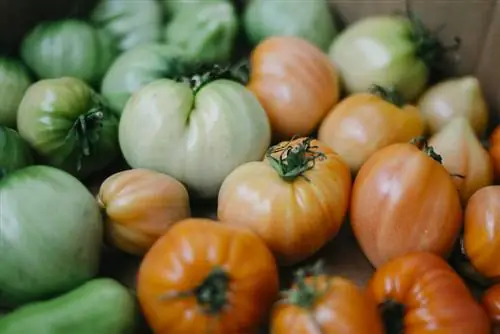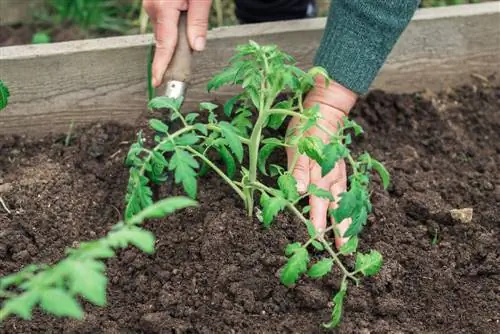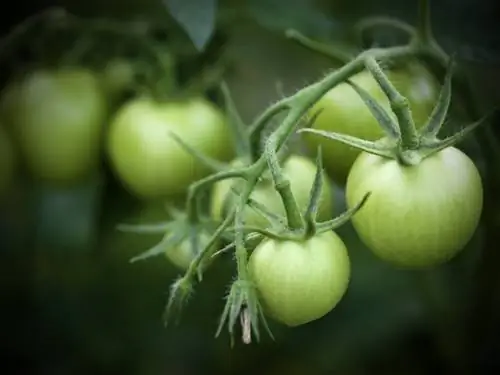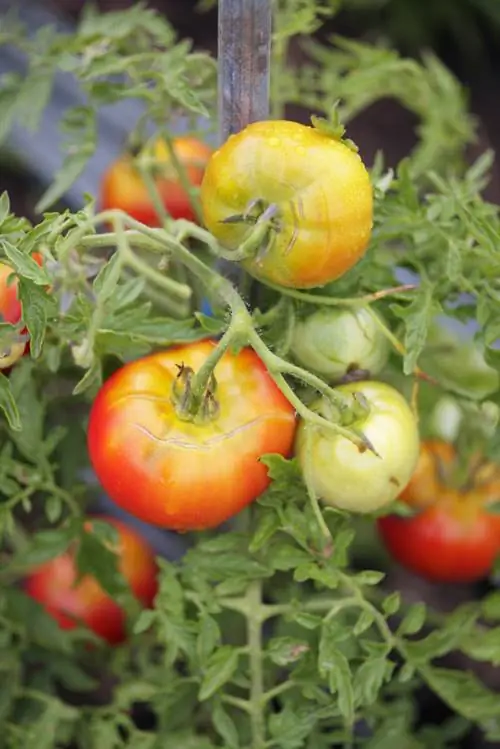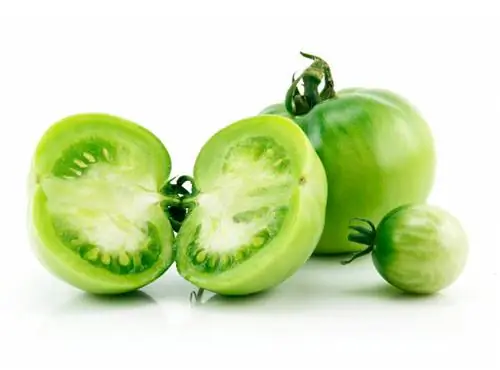- Author admin [email protected].
- Public 2023-12-16 16:46.
- Last modified 2025-06-01 06:02.
It's a nuisance when the last tomatoes no longer ripen. Despite their green color, the fruits do not have to be disposed of in the compost. There are methods to allow these to ripen. Those who are impatient can use the unripe specimens in the kitchen.
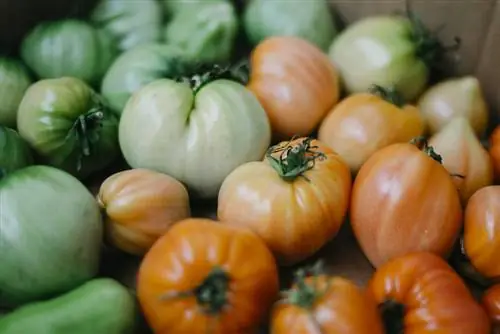
How do green tomatoes ripen?
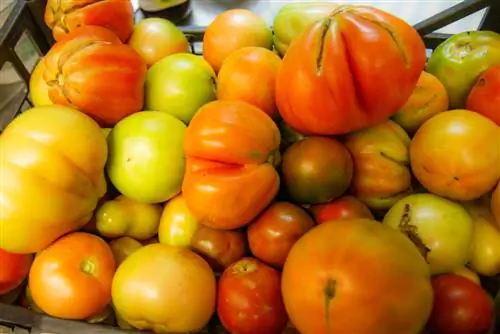
If the tomatoes are already slightly red, they often ripen completely even after the harvest
Green tomatoes are only suitable for storage when the flesh has ripened slightly. You can recognize this stage of ripeness by the yellowish, sticky flesh inside. Completely green specimens usually no longer ripen. If these are damaged by cracks, you should dispose of the fruits in the compost. Fungi or bacteria may already have settled in the pulp.
With intact tomatoes, the ripening process can be influenced by certain conditions. For better flavor, leave the stems on the fruit. Ideally, these are still attached to the plants so that you can store the entire plant until it matures. But the process also works with fallen vegetables.
Warm temperatures
If you have to harvest your tomatoes green in the fall because of the risk of frost, you can let the vegetables ripen in a warm environment. Temperatures between 18 and 20 degrees Celsius are ideal. Apples and bananas can accelerate ripening because these fruits release ripening gases. Tomatoes also secrete ethylene, which is why wrapping them in newspaper is a successful method for further ripening. The gas collects around the berries and accelerates the ripening process.
How green tomatoes ripen:
- cut off fully covered plants at the base
- Remove leaves from stem
- Hang the plant upside down
High humidity
Essential for the ripening process is high humidity, which should be at least 80 percent. A range between 86 and 90 percent is ideal. Caution is advised, because in cellar rooms that are too humid, tomatoes will rot quickly and fruit flies will be attracted. If the air is too dry, there is a risk of dehydration.
Red foil
Scientists have found that red foil has a positive effect on the ripening process. This reflects long-wave light frequencies that mobilize a specific protein in the tomato. She is led to believe that the plant is already bearing ripe fruit. A kind of competition arises in which immature specimens want to catch up with their supposedly mature neighbors. In this way, maturation is accelerated.

Storage tips
For ripening to work optimally, the tomatoes should still have a piece of the stem. This prevents fungi and bacteria from getting into the pulp. Regardless of how they are stored, you should check the tomatoes daily to quickly identify any damage. The tomatoes do not need light for the ripening process, which is why you can store the fruits in a dark room.
These places are suitable for storage:
- dark pantry
- warm boiler room
- cool pantry
Excursus
Maturity in the Darkness
The plant needs solar energy to develop sugar. These ensure a pleasant fruity sweetness. If the fruits are harvested green, the plant can no longer store sugar or other nutrients. As a result, ripened fruits usually taste watery and bland.
Sun-ripened tomatoes, on the other hand, have an intense taste. The fact that the fruits turn red even without sunlight depends on the dye they contain. In sunny locations they produce the pigment lycopene, which is a carotenoid. However, the biosynthesis of the substance does not require UV light and so green tomatoes turn red even in the dark.
Beet
If weather conditions permit, you should let tomatoes ripen in the greenhouse. To do this, the plant stem is bent and placed on a wooden slat or a permeable film. It is important that the fruits have no contact with the ground. Waterlogging impairs the ripening process and leads to mold formation. As soon as the outside temperature falls below twelve degrees Celsius, you should cover the plants with warming foil.
window sill
A small harvest also has space on the windowsill of the south window. In the sun you enjoy the advantage of accelerated ripening because the red pigment builds up more quickly in direct sunlight. Make sure that the temperatures do not fluctuate too much. If the fruit is stored at temperatures below ten degrees for a long time, the taste will be severely affected.
Paper bag
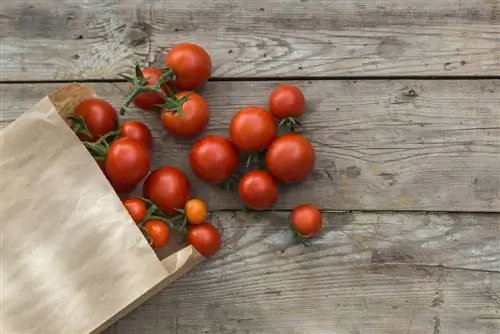
Tomatoes can also ripen in a paper bag
A more convenient storage method than loose newspaper is a paper bag. You can put several berries directly into the bag and seal it. A plastic bag is also suitable if it is previously provided with sufficient ventilation holes.
Carton and wooden basket
Larger quantities of tomatoes can be stored in a cardboard box or a wicker basket lined with newspaper. Place the fruit in the container so that they do not touch each other. You can also store your crops on top of each other if you place at least six layers of newspaper between the tiers. More than three layers endanger the lowest tomatoes.
Mason jar
Individual specimens can be placed in a screw-top or mason jar to save space. Through the glass you can optimally control the ripening. Make sure that the container is not completely full. When you close the lid, the fruit should move freely. This will help you avoid pressure points and prevent the formation of rot. It takes about two weeks for the tomatoes to turn red.
Römertopf
Clay vessels are ideal for storage because their porous structure ensures an optimal microclimate with moist conditions. To kill fungal spores and bacteria that may have settled in the container, you should place it in the heated oven for half an hour. Then fill the Roman pot completely with water so that the pores can soak up water. Pour off the water and dry the material roughly.
- Store the fruits loosely on top of each other
- Place the lid or clay coaster upside down on the vessel
- fill with water so that the humidity inside increases
- Put the container in a warm place
- check every two to three days
Are green tomatoes poisonous or edible?
Tomatoes belong to the nightshade family, which is known for its toxic ingredients. The plants contain the alkaloid solanine in all parts of the plant. The unripe fruits, which can hardly be distinguished from the rest of the plant because of their green color, also contain solanine. As the ripeness increases, the concentration of toxic solanine decreases. Ripe tomatoes, on the other hand, contain a lot of lycopene, which has a he alth-promoting effect.
| Concentration in ripe tomatoes | Recommended daily amount | |
|---|---|---|
| Potassium | 237 mg | 5% |
| Vitamin C | around 14 mg | 23 % |
| Vitamin E | around 1 mg | 4 % |
Solanine content
The information on solanine content varies depending on the source. Concentrations between nine and 32 milligrams of solanine per 100 grams of unripe fruit pulp are common. There are people who eat green tomatoes. In southern countries the unripe fruits are part of the menu, but in Central Europe the fear of solanine poisoning spoils the appetite.
Green tomatoes contain the poisonous solanine. However, consuming small amounts is harmless.
Many red tomato varieties are harvested when they are unripe, as they can withstand long transport routes better at this stage. They ripen until they are sold, whereby the solanine content drops to around two milligrams per 100 grams of half-ripe, orange-red fruits. Stiftung Warentest states that this amount is too small to cause poisoning. In fully mature specimens, the solanine content is less than one milligram.
Protection mechanism
Solanine has a bitter taste and is primarily used to ward off predators. In this way, the plant protects its immature seeds. Only when development is complete do the fruits turn an attractive red and the defensive substance solanine is broken down.
Can you eat green tomatoes?
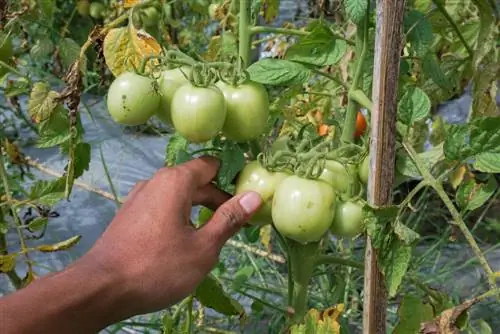
Unripe tomatoes are poisonous
The first signs of poisoning can occur after consuming 25 milligrams of solanine. An adult experiences severe symptoms from an amount of 200 milligrams. Consuming larger amounts damages the central nervous system and only an amount of 400 milligrams of solanine is considered a lethal dose. Excessive consumption can cause the following symptoms in humans:
- Stomach pain or inflammation of the gastric mucosa
- Nausea and vomiting
- Headache
- Itchy throat
To suffer initial poisoning, a person must consume 625 grams of unripe tomatoes in their raw state. However, this case is very unlikely as the bitter taste at such quantities is off-putting. If you consume small amounts of green tomatoes, you don't have to worry about poisoning. Stiftung Warentest reports in number 8/2003 that the solanine content in slightly green tomatoes is too low.
Ideas for using green tomatoes
Green tomatoes are considered edible under certain circumstances. This is already suggested by the film “Green Tomatoes”, in which two women from the southern states serve fried green tomatoes to the guests in their café. According to Stiftung Warentest, the solanine concentration of the pulp decreases when it is further processed. So you can also use unripe tomatoes sensibly and don't have to dispose of them in the compost.
Pickling green tomatoes
Solanine is resistant to acids, so the concentration does not decrease when pickled. Since the pickled fruits are eaten as a side dish and not in large quantities, they are still harmless to consume.
Quarter the tomatoes and place the pieces in a mason jar. Add garlic, onion rings, juniper berries, chili and peppercorns to taste and pour vinegar into the jar. Sugar and s alt refine the taste. The jar is closed and stored in a dark place for the next three weeks.
Cooking unripe fruits
If the harvest was not able to fully ripen, use undamaged specimens for delicious winter vegetables. Cut the tomatoes into small pieces and sprinkle them generously with s alt. After mixing well, let the fruit soak in the refrigerator overnight. The next day a lot of liquid has settled at the bottom of the vessel, which they strain out. Bring s alted water to the boil and add the tomatoes and other vegetables if desired:
- Carrots
- Onion
- Peppers
Taste the vegetables with parsley, chili and garlic and add some olive oil. The winter vegetables are cooked over low heat. Gently stir the stew to avoid mushing the tomatoes. Then add apple cider vinegar and let the winter vegetables steep. You can pour it into preserving jars and cook them in a water bath or in the oven.

Lactic fermentation
This form of preservation is extremely popular in Turkey. According to Stiftung Warentest, the solanine content of tomatoes has been reduced by 35 percent due to lactic acid fermentation. A small proportion of this is in the brine. This reduction is probably due to microbial activity. In this way, unripe tomatoes can be brought to a tolerable solanine concentration with the maximum value of 32 milligrams per 100 grams of pulp given in the literature
Procedure
Fill a one-liter jar four-fifths full with tomatoes and pour boiled s alted water over them. 15 grams of sea s alt per liter of water is sufficient. Add a fresh tarragon sprig and three tablespoons of whey to the jar and cover the base with a fresh grape leaf.
- Phase 1: store for one week at temperatures between 20 and 25 degrees
- Phase 2: Place the glass in a dark room at 15 degrees for the next two weeks
- Phase 3: store the fermentation vessel at zero to ten degrees for the last two to three weeks
Green Tomatoes - Recipes
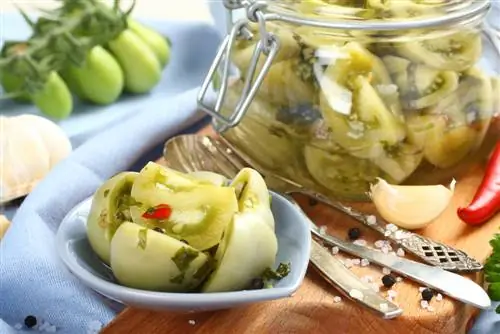
Green tomatoes, for example, can be pickled, but they are still slightly poisonous
You can find numerous dishes online that supposedly use green tomatoes. However, green tomatoes are not suitable for every recipe. “Tomato verde” is used in many southern dishes. However, this tomatillo is not a green tomato, but belongs to the bladder cherry family. In some recipes, the fruit has been literally translated as “green tomato,” which leads to confusion. The difference in taste will quickly become clear if you try such recipes with the tomatillo instead of an unripe tomato.
Green tomatoes in chutney
Solanine is heat stable and cannot be destroyed by cooking. To reduce the toxicity of the chutney, you should use unripe tomatoes with half-ripe tomatoes. Additional ingredients further reduce the solanine concentration in the end product. Chutneys can be made with fallen fruit such as apples or plums. You can add raisins and chili peppers if desired.
Basic recipe:
- Dice ginger, garlic and onions
- steam in a pan with a little olive oil
- Cut tomatoes and apples into small cubes
- Add to the pan and fry lightly
- season with coriander, cloves and turmeric
- Pour apple cider vinegar and bring to a boil
- Simmer for two hours until a thick consistency is formed
Tip
Listen to your gut feeling and use all your senses. If the taste of green tomatoes seems too bitter for you, stay away.
Green jam
In jams, the addition of preserving sugar ensures dilution. This can reduce the solanine content by 35 percent. In this way you can also use completely unripe tomatoes. If you enjoy the jam sparingly, there is no risk of poisoning. The preparation is carried out according to the instructions on the preserving sugar.
Ingredients:
- 500 grams of unripe tomatoes
- 500 grams of preserving sugar in a ratio of 1:1
- a shot of brown rum
- ground cinnamon
- ground vanilla beans
- Orange flavor
The difference between unripe and green tomatoes
The plants of green-ripe varieties hardly differ externally from the plants with red fruits. When planting different varieties in your greenhouse, identifying green-ripe and unripe tomatoes is not easy. Pay attention to subtle nuances, because green-ripe tomatoes are slightly lighter green when ripe than unripe fruits. If you gently press the fruit, the pulp will give slightly.
Do green varieties contain solanine?

There are tomato varieties that retain their green color even when ripe
There are now a whole range of varieties available that retain their green color even when fully ripe. But these varieties also have negligible amounts of solanine when the tomatoes are fully ripe. If you want to be on the safe side and don't want to make green chutneys or soups from unripe fruits, you can use these green, ripe varieties:
- ‘Green Zebra’
- ‘Dorothy’s Green’
- ‘Evergreen’
- ‘Green Grape’
- ‘Lime Green Salad’
Tip
Ripe tomatoes - whether red or green - should not be stored in the refrigerator because the cold has a negative impact on the aroma.
Green ripe tomato soup with foam
Wash green ripe fruits and put them in a blender. Together with fresh basil leaves and a little s alt, they are mixed into a paste. Pour the mixture into a fine sieve, which is placed in a bowl overnight. The juice drips slowly and collects in the bowl without any pulp. You can also press the puree through a cloth to get a clear tomato water.
Chop the garlic into large pieces and fry it in a little olive oil. Add about 500 grams of sliced green tomatoes and season the pan with a little white wine vinegar, s alt and pepper. Let the mixture simmer for about 15 minutes so that the tomatoes release their liquid. After cooling, the porridge is pressed through a fine sieve to create a creamy broth. Add the tomato water.
For the milk foam, briefly boil chopped garlic in milk. Add roughly chopped basil leaves and let the milk steep for 20 minutes. Then strain out the coarse ingredients and froth the milk. It is added to the tomato soup before consumption.
Frequently asked questions
How do green tomatoes turn red?
The berries primarily need warmth to ripen. Tomatoes ripen optimally in the sun. However, the air must not be too dry, otherwise the pulp will dry out too quickly. Ideal conditions for ripening are at temperatures between 18 and 20 degrees Celsius and humidity of at least 80 percent.
Place the unripe fruits on a red foil because the reflected light accelerates ripening. Apples, bananas and apricots also ensure that the processes run faster thanks to their ripening gases.
Are green tomato seeds poisonous?
In many dishes, the inner workings of the tomato are removed before preparation. The motives for this approach are different. Some people are afraid of the risk of poisoning, while other cooks want to avoid any compromise in taste. The fact is that tomato seeds in normal consumption quantities do not pose any he alth risks. The University of Reading has found that the seeds and their gel-like coating contain eleven times more glutamate than the pulp. As a result, the interior turns out to be a natural flavor enhancer.
What is lycopene?
This dye is a natural product that is produced to protect against sunlight. Excessive sun causes tomatoes to turn red faster. But sunlight is not necessarily required to produce the dye. Green tomatoes turn red even in the dark, provided the temperatures are right.
Lycopene has a special importance for human he alth. It strengthens the immune system and protects against various types of cancer and circulatory diseases. People with a high proportion of lycopene in their blood have more youthful skin and are less prone to wrinkles.
Can the seeds in the tomato germinate?
Ripe tomatoes were discovered in 2005 with seeds germinating in their flesh. Scientists explain this phenomenon by the beginning of fermentation and degradation processes that begin with fallen tomatoes. This gives the seeds the information that fruit growth is complete. They germinate when the fruits are overripe and the weather conditions are right. This premature germination is one of the exceptions and could also be genetically influenced.
Are seedlings in tomatoes edible?
The green plant parts of tomatoes contain various solanum glycoalkaloids, which are summarized as the active ingredient solanine. They protect the plant from predators and have a toxic effect. Nevertheless, eating green parts of plants or tomato seedlings is not fundamentally dangerous. The amount influences the poisonous effect. To a small extent, an adult does not have to fear any discomfort.
Are green spots on ripe tomatoes poisonous?
Solanine is also contained in the stalk of the tomato or in the green areas of ripening fruits. The further the ripening process progresses, the lower the solanine concentration. Many people cut out the stem out of concern for their own he alth. But in such small quantities, consuming green plant parts is completely harmless and you don't have to worry about poisoning.

